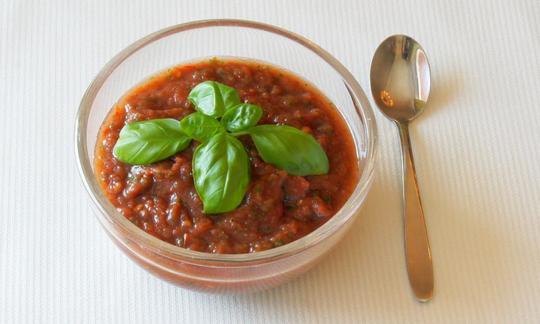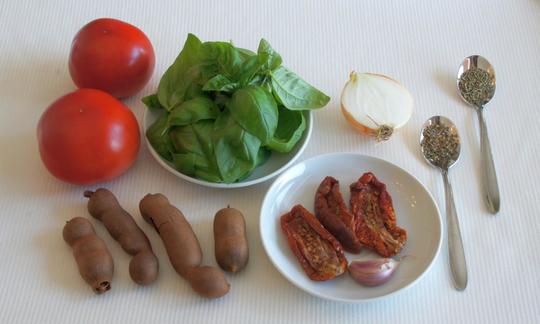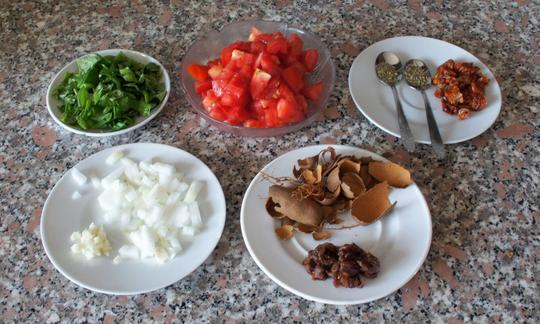tomato sauce with tamarind, basil and onion
raw-vegan
Ingredients (for servings, )
| For the sauce base | |
|---|---|
| 2 | Tomatoes, raw (organic?) (8.6 oz) |
| 3 | Tomatoes, dried (raw?, organic?) (0.53 oz) |
| 2 | Tamarinds, raw (organic?) (0.45 oz) |
| ⅓ | Onions, raw (organic?) (1.3 oz) |
| 1 clove | Garlic (organic?) (0.11 oz) |
| To refine the taste | |
| 4 dash | Table salt (table salt, raw?, organic?) (0.06 oz) |
| ½ tsp | Marjoram, dried (raw?, organic?) (0.01 oz) |
| ¼ bunch | Basil, fresh (organic?) (0.35 oz) |
| ½ tsp, ground | Oregano, dried (raw?, organic?) (0.03 oz) |
Equipment
- hand-held blender / immersion blender or blender
Type of preparation
- food preparation without heating
- blend
- remove the skin
- rinse with cold water
Preparation
For the sauce base
Wash the fresh tomatoes, cut them into small pieces and place them in a measuring cup together with the dried tomatoes.Peel the tamarind and use a knife to separate the flesh from the stone. Put the pieces into the measuring cup and use a hand blender to puree the tomatoes and tamarind into a creamy mass.
Peel the onion and garlic clove and chop roughly. Add both to the sauce.
To refine the taste
Season the sauce with salt, marjoram, basil and oregano. Stir everything well - the delicious tomato sauce is ready.For a visual presentation, we recommend garnishing with basil and chives.
|
Nutritional Information per person
Convert per 100g
|
2000 kcal | |
|---|---|---|
| Energy | 35 kcal | 1.7% |
| Fat/Lipids | 0.30 g | 0.4% |
| Saturated Fats | 0.05 g | 0.3% |
| Carbohydrates (inc.dietary fiber) | 7.9 g | 2.9% |
| Sugars | 4.7 g | 5.2% |
| Fiber | 1.7 g | 6.8% |
| Protein/Albumin | 1.4 g | 2.8% |
| Cooking Salt (Na:163.7 mg) | 416 mg | 17.3% |
| Essential micronutrients with the highest proportions | per person | 2000 kcal | |
|---|---|---|---|
| Vit | Vitamin K | 19 µg | 25.0% |
| Sodium, Na | 164 mg | 20.0% | |
| Elem | Potassium, K | 322 mg | 16.0% |
| Vit | Vitamin C (ascorbic acid) | 11 mg | 14.0% |
| Min | Copper, Cu | 0.11 mg | 11.0% |
| Min | Manganese, Mn | 0.21 mg | 10.0% |
| Vit | Folate, as the active form of folic acid (née vitamin B9 and | 16 µg | 8.0% |
| Vit | Vitamin B6 (pyridoxine) | 0.09 mg | 7.0% |
| Vit | Biotin (ex vitamin B7, H) | 3.7 µg | 7.0% |
| Min | Iron, Fe | 0.85 mg | 6.0% |
Detailed Nutritional Information per Person for this Recipe
The majority of the nutritional information comes from the USDA (US Department of Agriculture). This means that the information for natural products is often incomplete or only given within broader categories, whereas in most cases products made from these have more complete information displayed.
If we take flaxseed, for example, the important essential amino acid ALA (omega-3) is only included in an overarching category whereas for flaxseed oil ALA is listed specifically. In time, we will be able to change this, but it will require a lot of work. An “i” appears behind ingredients that have been adjusted and an explanation appears when you hover over this symbol.
For Erb Muesli, the original calculations resulted in 48 % of the daily requirement of ALA — but with the correction, we see that the muesli actually covers >100 % of the necessary recommendation for the omega-3 fatty acid ALA. Our goal is to eventually be able to compare the nutritional value of our recipes with those that are used in conventional western lifestyles.
| Essential fatty acids | per person | 2000 kcal |
|---|---|---|
| Alpha-Linolenic acid; ALA; 18:3 omega-3 | 0.01 g | 1.0% |
| Linoleic acid; LA; 18:2 omega-6 | 0.10 g | 1.0% |
| Essential amino acids | per person | 2000 kcal |
|---|---|---|
| Tryptophan (Trp, W) | 0.01 g | 4.0% |
| Threonine (Thr, T) | 0.04 g | 4.0% |
| Lysine (Lys, K) | 0.05 g | 3.0% |
| Isoleucine (Ile, I) | 0.03 g | 2.0% |
| Leucine (Leu, L) | 0.05 g | 2.0% |
| Phenylalanine (Phe, F) | 0.04 g | 2.0% |
| Valine (Val, V) | 0.03 g | 2.0% |
| Methionine (Met, M) | 0.01 g | 1.0% |
| Vitamins | per person | 2000 kcal |
|---|---|---|
| Vitamin K | 19 µg | 25.0% |
| Vitamin C (ascorbic acid) | 11 mg | 14.0% |
| Folate, as the active form of folic acid (née vitamin B9 and | 16 µg | 8.0% |
| Vitamin B6 (pyridoxine) | 0.09 mg | 7.0% |
| Biotin (ex vitamin B7, H) | 3.7 µg | 7.0% |
| Thiamine (vitamin B1) | 0.06 mg | 6.0% |
| Niacin (née vitamin B3) | 0.82 mg | 5.0% |
| Vitamin A, as RAE | 35 µg | 4.0% |
| Riboflavin (vitamin B2) | 0.04 mg | 3.0% |
| Pantothenic acid (vitamin B5) | 0.16 mg | 3.0% |
| Vitamin E, as a-TEs | 0.40 mg | 3.0% |
| Essential macroelements (macronutrients) | per person | 2000 kcal |
|---|---|---|
| Sodium, Na | 164 mg | 20.0% |
| Potassium, K | 322 mg | 16.0% |
| Magnesium, Mg | 21 mg | 5.0% |
| Phosphorus, P | 37 mg | 5.0% |
| Calcium, Ca | 26 mg | 3.0% |
| Essential trace elements (micronutrients) | per person | 2000 kcal |
|---|---|---|
| Copper, Cu | 0.11 mg | 11.0% |
| Manganese, Mn | 0.21 mg | 10.0% |
| Iron, Fe | 0.85 mg | 6.0% |
| Zinc, Zn | 0.24 mg | 2.0% |
| Selenium, Se | 0.42 µg | 1.0% |
| Iod, I (Jod, J) | 1.0 µg | 1.0% |
| Fluorine, F | 1.9 µg | < 0.1% |
This raw tomato sauce with fresh basil has a fruity, sweet taste thanks to the tamarind, despite the onion. It is quick to prepare.
Salt and dried tomatoes: High-quality, sun-dried tomatoes are not salted. However, if you have a salty variety, you can omit the salt completely for this recipe.
Use for Gazpacho: You can also use the dish for a so-called "Gazpacho". This is a cold vegetable soup from the Spanish and Portuguese speaking areas.
No tears when cutting onions: Chill the onions in the freezer for five to ten minutes before cutting them. This reduces the amount of enzymes that irritate the human eye and are released into the air during the preparation process. In addition, the temporary cooling process does not affect the taste, so the quality of the recipe is not affected.
Fresh herbs: You can replace marjoram and oregano with fresh varieties. In this case, it is recommended to use nine to ten times the stated weight of dry spices.








